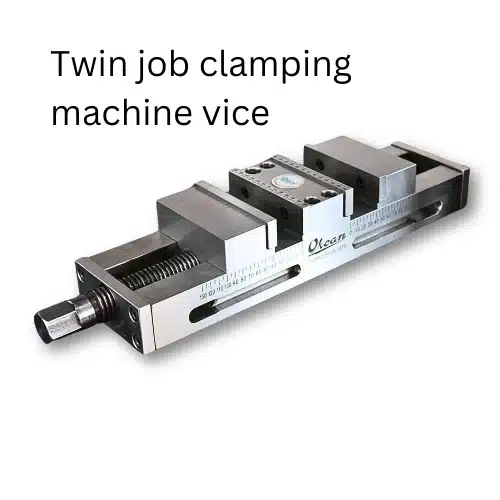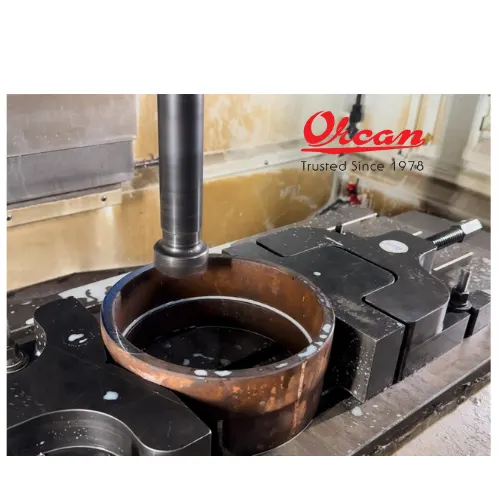
Why Cutting Tools Dealers can benefit selling orcan machine vices
Tool life and job finish cost of workpiece machining are the key points of concern for cutting tool dealers. Without a reliable vice, even the best cutting tools and VMC settings can fail to produce optimal results. Unstable work holding leads to vibrations, misalignment, or slippage, causing tool wear, poor surface quality, and dimensional inaccuracies. Vices bridge the gap between the VMC’s capabilities and the workpiece, ensuring that cutting tools perform at their peak and the workpiece meets stringent quality standards.
As a cutting tool dealer, your responsibility goes beyond just selling tools. Understanding the tools used in Vertical Machining Centers, including cutting speed (Ap, Ae), tool selection, and coolant flow, is crucial. However, equally important is ensuring workholding precision, speed, repeatability, and the type of coolant used. Your attention to these details can make or break a machining process.
Why Sell Orcan machine vices
Orcan Vices can Increase Productivity of your client


We can manufacture customized vices to suit your client job/machine needs
Why Vices Are Critical
- Stability and Rigidity: Vices securely clamp the workpiece, minimizing vibration and movement during machining. This stability allows cutting tools to maintain consistent contact with the material, reducing tool deflection and wear. For example, a rigid vise prevents chatter, a common issue that can prematurely dull tools, ensuring the durability of your tools.
- Precision Alignment: High-quality vices play a crucial role in ensuring precise workpiece positioning, thereby enabling accurate tool paths. This not only reduces errors in cutting but also reassures you about the precision of your work, prolonging tool life by preventing uneven wear or damage from misalignment.
- Consistent Clamping Force: Vices apply uniform pressure, preventing workpiece slippage. This consistency allows tools to operate at optimal speeds and feeds, significantly improving efficiency and empowering you to maximize your productivity while reducing the risk of tool breakage.
 Vibration Dampening: By firmly holding the workpiece, vices absorb and minimize vibrations caused by high-speed machining, which is the process of removing material at high speeds. This leads to smoother surface finishes, as vibrations often cause tool marks or roughness.
Vibration Dampening: By firmly holding the workpiece, vices absorb and minimize vibrations caused by high-speed machining, which is the process of removing material at high speeds. This leads to smoother surface finishes, as vibrations often cause tool marks or roughness.- Precision in Positioning: Vices with high repeatability (e.g., precision-ground jaws or modular designs) ensure the workpiece is held identically across multiple setups. This precision instills confidence in the machinist, eliminating variations that could lead to surface imperfections.
- Maintaining Dimensional Accuracy: Properly designed vices distribute clamping force evenly, preventing workpiece distortion. This is a key responsibility for machinists, as it is critical for maintaining dimensional accuracy and achieving a polished finish, especially on delicate or thin materials.
 Secure Workpiece Immobilization: Vices act as the primary workholding mechanism, anchoring the workpiece to the VMC table. This eliminates movement under cutting forces, ensuring tools cut precisely where intended.
Secure Workpiece Immobilization: Vices act as the primary workholding mechanism, anchoring the workpiece to the VMC table. This eliminates movement under cutting forces, ensuring tools cut precisely where intended.- Versatile Clamping Solutions: Vices can be tailored (e.g., soft jaws, stepped jaws, or pneumatic vices) to fit even the most complex geometries, ensuring an optimal grip without any risk of damaging the workpiece. This adaptability supports intricate machining tasks, improving both tool performance and finish.
- Secure Force Management: Vices balance a sufficient clamping force to prevent any slippage with a controlled pressure that ensures no workpiece damage. This balance is crucial for maintaining material integrity and achieving high-quality surface finishes, thereby providing a secure environment for machining tasks.
- Integration with VMC Automation: Advanced vices (e.g., hydraulic or pneumatic) integrate with automated VMC systems, enabling quick setup changes such as switching from one workpiece to another or adjusting the clamping force, and consistent clamping for high-volume production. This reduces downtime and ensures uniform tool performance across batches.
Benefits of Dealership
Presales Support
Empowering informed decisions through expert guidance in the presales journey
